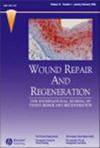Further psychometric evaluation of the WOUND‐Q: A responsiveness study
IF 3.8
3区 医学
Q2 CELL BIOLOGY
引用次数: 0
Abstract
The WOUND‐Q is a modular patient‐reported outcome measure (PROM) with 13 scales measuring constructs across 4 domains (i.e., wound characteristics, health related quality of life, experience of care and wound treatment). The psychometrics of the WOUND‐Q were previously assessed and the 13 scales evidenced good validity and reliability. However, the responsiveness (i.e., ability to detect clinical change) of the WOUND‐Q has yet to be assessed. The objective of this study was to evaluate responsiveness for 9 WOUND‐Q scales that assess outcomes, in a sample of people 18 years of age or older with chronic wounds that were present for at least 3 months. This study conducted a 4 month follow‐up of 421 participants who completed the WOUND‐Q as part of a previous psychometric study. Participants completed an online survey answering questions about their current wound state (e.g., number, type, size, smell, drainage), anchor questions about change, as well as the WOUND‐Q scales that they had completed in their initial assessment. Pre‐defined hypotheses were tested with a 75% acceptance threshold indicating sufficient evidence of responsiveness. Minimally important differences (MIDs) were also calculated using both anchor‐based and distribution‐based methods. Of 390 invited participants, 320 provided responses, ranging in age from 19 to 84 years. Acceptance of hypotheses ranged from 60% to 100%, with only the Symptom scale not meeting the 75% threshold. The findings of this study provide evidence that the WOUND‐Q can validly measure clinical change in patients with chronic wounds.WOUND-Q 的进一步心理计量评估:响应性研究
WOUND-Q 是一种模块化的患者报告结果量表 (PROM),共有 13 个量表,测量 4 个领域(即伤口特征、与健康相关的生活质量、护理体验和伤口治疗)的结构。此前曾对 WOUND-Q 的心理测量学进行过评估,13 个量表具有良好的有效性和可靠性。然而,WOUND-Q 的反应性(即检测临床变化的能力)还有待评估。本研究的目的是评估 9 个 WOUND-Q 量表的响应性,这些量表评估的是 18 岁或以上、有慢性伤口且伤口存在至少 3 个月的人群的结果。这项研究对 421 名参与者进行了为期 4 个月的跟踪调查,这些参与者在之前的心理测量研究中完成了 WOUND-Q 的测试。参与者完成了一项在线调查,回答了有关其当前伤口状态(如数量、类型、大小、气味、引流情况)的问题、有关变化的锚定问题以及他们在初次评估中完成的 WOUND-Q 量表。对预先确定的假设进行了测试,接受阈值为 75%,表明有足够的证据表明存在响应性。此外,还使用基于锚和基于分布的方法计算了最小重要差异(MID)。在 390 名受邀参与者中,有 320 人做出了回应,他们的年龄从 19 岁到 84 岁不等。对假设的接受度从 60% 到 100% 不等,只有症状量表没有达到 75% 的临界值。这项研究结果证明,WOUND-Q 可以有效测量慢性伤口患者的临床变化。
本文章由计算机程序翻译,如有差异,请以英文原文为准。
求助全文
约1分钟内获得全文
求助全文
来源期刊

Wound Repair and Regeneration
医学-皮肤病学
CiteScore
5.90
自引率
3.40%
发文量
71
审稿时长
6-12 weeks
期刊介绍:
Wound Repair and Regeneration provides extensive international coverage of cellular and molecular biology, connective tissue, and biological mediator studies in the field of tissue repair and regeneration and serves a diverse audience of surgeons, plastic surgeons, dermatologists, biochemists, cell biologists, and others.
Wound Repair and Regeneration is the official journal of The Wound Healing Society, The European Tissue Repair Society, The Japanese Society for Wound Healing, and The Australian Wound Management Association.
 求助内容:
求助内容: 应助结果提醒方式:
应助结果提醒方式:


